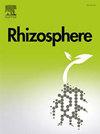青豆种子和根际细菌群落向子代的传播
IF 3.4
3区 生物学
Q1 PLANT SCIENCES
引用次数: 0
摘要
细菌群落从种子和根际向子代的传播可能对下一代植物具有重要意义。因此,我们评估了细菌分类群从种子和根际向后代传播的可能性,并评估了土壤、根际和各种植物室(包括根、叶和种子)中细菌群落的组成。播种利马豆种子,在开花期间对土壤、根际、根、叶和种子(后代)进行取样。用区域特异性引物对16S rRNA基因的V4区和V57区分别进行了土壤/根际和植物的测序。在门和属水平上,细菌群落的组成在土壤和植物区室中都存在差异。放线菌门在土壤和根际中丰富,变形菌门在种子和植物组织中丰富。属水平的差异包括土壤、根际和根中的芽孢杆菌,叶片中的假单胞菌,种子中的不动杆菌和假单胞菌。共享和排他性分类群在种子和后代中突出了区隔特异性。种子和子代分别有9个和6个单独的细菌分类群,其中有不动杆菌、假单胞菌和酸杆菌。本研究确定了不同植物隔室的细菌分类群,并表明细菌传播给后代突出了下一代的潜力。本文章由计算机程序翻译,如有差异,请以英文原文为准。
Transmission of bacterial community from seeds and rhizosphere to progeny in lima bean (Phaseolus lunatus)
The transmission of bacterial community from seeds and rhizosphere to progeny may have significant implications to next plant generations. Therefore, we evaluated the potential for transmission of bacterial taxa from seeds and rhizosphere to progeny and assessed the composition of the bacterial community in the soil, rhizosphere, and various plant compartments, including roots, leaves, and seeds. Seeds of lima bean (Phaseolus lunatus) were sown and during the flowering period, the soil, rhizosphere, roots, leaves, and seeds (progeny) were sampled. The V4 and V57 regions of 16S rRNA gene with region-specific primers were sequenced to soil/rhizosphere and plant, respectively. The composition of bacterial communities varied across soil and plant compartments at both the phylum and genus levels. Actinobacteria was abundant in soil and rhizosphere, while Proteobacteria was abundant in seeds and plant tissues. Genus-level differences included Bacillus in soil, rhizosphere, and roots, Pseudomonas in leaves, and Acinetobacter and Pseudomonas in seeds. Shared and exclusive taxa highlighted compartmental specificity in seeds and progeny. Thus, seeds and progeny exhibited 9 and 6 exclusive bacterial taxa, respectively, with Acinetobacter, Pseudomonas, and Acidibacter shared between them. This study identified distinct bacterial taxa across plant compartments and shows thar bacterial transmission to progeny highlights potential for next generations.
求助全文
通过发布文献求助,成功后即可免费获取论文全文。
去求助
来源期刊

Rhizosphere
Agricultural and Biological Sciences-Agronomy and Crop Science
CiteScore
5.70
自引率
8.10%
发文量
155
审稿时长
29 days
期刊介绍:
Rhizosphere aims to advance the frontier of our understanding of plant-soil interactions. Rhizosphere is a multidisciplinary journal that publishes research on the interactions between plant roots, soil organisms, nutrients, and water. Except carbon fixation by photosynthesis, plants obtain all other elements primarily from soil through roots.
We are beginning to understand how communications at the rhizosphere, with soil organisms and other plant species, affect root exudates and nutrient uptake. This rapidly evolving subject utilizes molecular biology and genomic tools, food web or community structure manipulations, high performance liquid chromatography, isotopic analysis, diverse spectroscopic analytics, tomography and other microscopy, complex statistical and modeling tools.
 求助内容:
求助内容: 应助结果提醒方式:
应助结果提醒方式:


